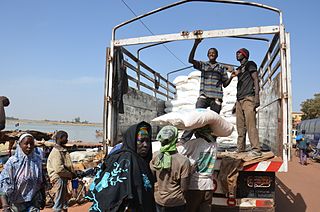Related Research Articles

Immunization, or immunisation, is the process by which an individual's immune system becomes fortified against an infectious agent.
James Pineo Grant was an American diplomat and children's advocate. Grant served for 15 years as the third executive director of the United Nations Children's Emergency Fund (UNICEF), with the rank of Under Secretary-General.
The United Nations World Summit for Children was held in the United Nations Headquarters in New York City on 29–30 September 1990. The summit had the then-largest-ever gathering of heads of state and government to commit to a set of goals to improve the well-being of children worldwide by the year 2000. It was the first time a UN conference had set a broad agenda for a wide range of goals in health, education, nutrition and human rights.

The DPT vaccine or DTP vaccine is a class of combination vaccines against three infectious diseases in humans: diphtheria, pertussis, and tetanus (lockjaw). The vaccine components include diphtheria and tetanus toxoids, and either killed whole cells of the bacterium that causes pertussis or pertussis antigens. The term toxoid refers to vaccines which use an inactivated toxin produced by the pathogen which they are targeted against to generate an immune response. In this way, the toxoid vaccine generates an immune response which is targeted against the toxin which is produced by the pathogen and causes disease, rather than a vaccine which is targeted against the pathogen itself. The whole cells or antigens will be depicted as either "DTwP" or "DTaP", where the lower-case "w" indicates whole-cell inactivated pertussis and the lower-case "a" stands for "acellular". In comparison to alternative vaccine types, such as live attenuated vaccines, the DTP vaccine does not contain any live pathogen, but rather uses inactivated toxoid to generate an immune response; therefore, there is not a risk of use in populations that are immune compromised since there is not any known risk of causing the disease itself. As a result, the DTP vaccine is considered a safe vaccine to use in anyone and it generates a much more targeted immune response specific for the pathogen of interest.

Pulse Polio is an immunisation campaign established by the government of India to eliminate poliomyelitis (polio) in India by vaccinating all children under the age of five years against the polio virus. The project fights polio through a large-scale, pulse vaccination programme and monitoring for poliomyelitis cases.

Oral rehydration therapy (ORT) is a type of fluid replacement used to prevent and treat dehydration, especially due to diarrhea. It involves drinking water with modest amounts of sugar and salts, specifically sodium and potassium. Oral rehydration therapy can also be given by a nasogastric tube. Therapy can include the use of zinc supplements to reduce the duration of diarrhea in infants and children under the age of 5. Use of oral rehydration therapy has been estimated to decrease the risk of death from diarrhea by up to 93%.

Child mortality is the mortality of children under the age of five. The child mortality rate refers to the probability of dying between birth and exactly five years of age expressed per 1,000 live births.

ICDDR,B is an international health research organisation located in Dhaka, Bangladesh. Dedicated to saving lives through research and treatment, ICDDR,B addresses some of the most critical health concerns facing the world today, ranging from improving neonatal survival to HIV/AIDS. In collaboration with academic and research institutions over the world, ICDDR,B conducts research, training and extension activities, as well as programme-based activities, to develop and share knowledge for global lifesaving solutions.
The Expanded Program on Immunization(EPI) in the Philippines began in 1976 through Presidential Decree No. 996 signed by President Ferdinand Marcos. And, in 1986, made a response to the Universal Child Immunization goal. The four major strategies include:
- sustaining high routine Full Immunized Child (FIC) coverage of at least 90% in all provinces and cities;
- sustaining the polio-free country for global certification;
- eliminating measles by 2008; and
- eliminating neonatal tetanus by 2008.

Neonatal tetanus is a form of generalised tetanus that occurs in newborns. Infants who have not acquired passive immunity from an immunized mother are at risk. It usually occurs through infection of the unhealed umbilical stump, particularly when the stump is cut with a non-sterile instrument. Neonatal tetanus mostly occurs in developing countries, particularly those with the least developed health infrastructure. It is rare in developed countries.
Health in Afghanistan remains poor but steadily improving. It has been negatively affected by the nation's environmental issues and the decades of war since 1978. The Ministry of Public Health (MoPH) oversees all matters concerning the health of the country's residents. The Human Rights Measurement Initiative finds that Afghanistan is fulfilling 72.5% of what it should be fulfilling for the right to health based on its level of income.

Mali, one of the world's poorest nations, is greatly affected by poverty, malnutrition, epidemics, and inadequate hygiene and sanitation. Mali's health and development indicators rank among the worst in the world, with little improvement over the last 20 years. Progress is impeded by Mali's poverty and by a lack of physicians. The 2012 conflict in northern Mali exacerbated difficulties in delivering health services to refugees living in the north. With a landlocked, agricultural-based economy, Mali is highly vulnerable to climate change. A catastrophic harvest in 2023 together with escalations in armed conflict have exacerbated food insecurity in Northern and Central Mali.
The Expanded Program on Immunization is a World Health Organization program with the goal to make vaccines available to all children.
The Republic of Moldova has a universal health care system.

The 2010 maternal mortality rate per 100,000 births for Tanzania was 790. This is compared with 449 in 2008 and 610.2 in 1990. The UN Child Mortality Report 2011 reports a decrease in under-five mortality from 155 per 1,000 live births in 1990 to 76 per 1,000 live births in 2010, and in neonatal mortality from 40 per 1,000 live births to 26 per 1,000 live births. The aim of the report The State of the World's Midwifery is to highlight ways in which the Millennium Development Goals can be achieved, particularly Goal 4 – Reduce child
Universal Immunisation Programme (UIP) is a vaccination programme launched by the Government of India in 1985. It became a part of Child Survival and Safe Motherhood Programme in 1992 and is currently one of the key areas under the National Health Mission since 2005. The programme now consists of vaccination for 12 diseases- tuberculosis, diphtheria, pertussis, tetanus, poliomyelitis, measles, hepatitis B, rotaviral gastroenteritis, Japanese encephalitis, rubella, pneumonia and Pneumococcal diseases. Hepatitis B and Pneumococcal diseases were added to the UIP in 2007 and 2017 respectively. The cost of all the vaccines are borne entirely by the Government of India and is funded through taxes with a budget of ₹7,234 crore (US$910 million) in 2022 and the program covers all residents of India, including foreign residents.
The State of the World's Children is an annual report published by the United Nations Children's Fund (UNICEF). It is the flagship publication of the organization. The first report was published in 1980, having been introduced by James P. Grant. Peter Adamson was the author of the report for 15 years. The publication of the 1982–1983 The State of the World's Children report marked the start of the child survival revolution.

Child health and nutrition in Africa is concerned with the health care of children through adolescents in the various countries of Africa. The right to health and a nutritious and sufficient diet are internationally recognized human rights that are protected by international treaties. Millennium Development Goals (MDGs) 1, 4, 5 and 6 highlight, respectively, how poverty, hunger, child mortality, maternal health, the eradication of HIV/AIDS, malaria, tuberculosis and other diseases are of particular significance in the context of child health.
Child Mortality in Ghana describes the child mortality in the country of Ghana. Like in other parts of the world, child mortality is declining in Ghana.
DTaP-IPV-HepB vaccine is a combination vaccine whose generic name is diphtheria and tetanus toxoids and acellular pertussis adsorbed, hepatitis B (recombinant) and inactivated polio vaccine or DTaP-IPV-Hep B. It protects against the infectious diseases diphtheria, tetanus, pertussis, poliomyelitis, and hepatitis B.
References
- 1 2 3 Kul Chandra Gautam (August 22, 2012). "USAID and UNICEF: A Winning Partnership for Child Survival and Development". Huffington Post.
- ↑ Bill Gates (February 17, 2011). "Jim Grant's 'Child Survival Revolution'".
- 1 2 3 4 "The 1980s: Campaign for child survival". UNICEF. Archived from the original on 2016-06-05. Retrieved 2016-05-11.
- 1 2 3 4 5 6 7 Peter Adamson; Carol Bellamy; Kul Gautam; Richard Jolly; Nyi Nyi; Mary Racelis; Richard Reid; Jon Rohde (2001). Jim Grant: UNICEF Visionary. UNICEF Innocenti Research Centre. Archived from the original on 2016-06-05. Retrieved 2016-05-11.
- 1 2 Primary Health Care: Report of the International Conference on Primary Health Care (PDF) (Report). Geneva: World Health Organization. 1978. Archived from the original (PDF) on 2017-08-29. Retrieved 2016-05-11.
- ↑ "Global Health Timeline". Archived from the original on April 3, 2016. Retrieved April 8, 2016.
- 1 2 C. Schuftan (1990). "The Child Survival Revolution: a critique". Family Practice.
- ↑ CELIA W. DUGGER (7 May 2007). "Some countries report hopeful trends in child mortality". The New York Times .
- ↑ Maggie Black, Children First: The Story of UNICEF, Past and Present (New York: Oxford University Press, 1996), 33; see also UNICEF, The State of the World’s Children 1986 (New York: Oxford University Press, 1985), 5.
- 1 2 3 D. A. Henderson (1990). "The Child Survival Revolution". Pediatric Research.
- ↑ Daniel C. Taylor and Carl E. Taylor (2016), Just and Lasting Change: When Communities Own Their Futures 2nd Edition (New York: Johns Hopkins University Press, p176-177)
- ↑ David Bornstein (2007). How to Change the World: Social Entrepreneurs and the Power of New Ideas New York: Oxford University Press pp. 250